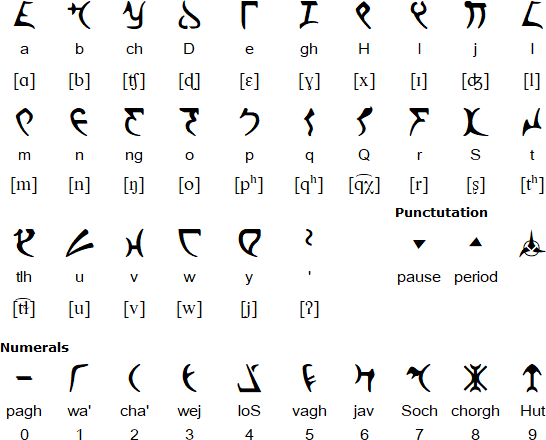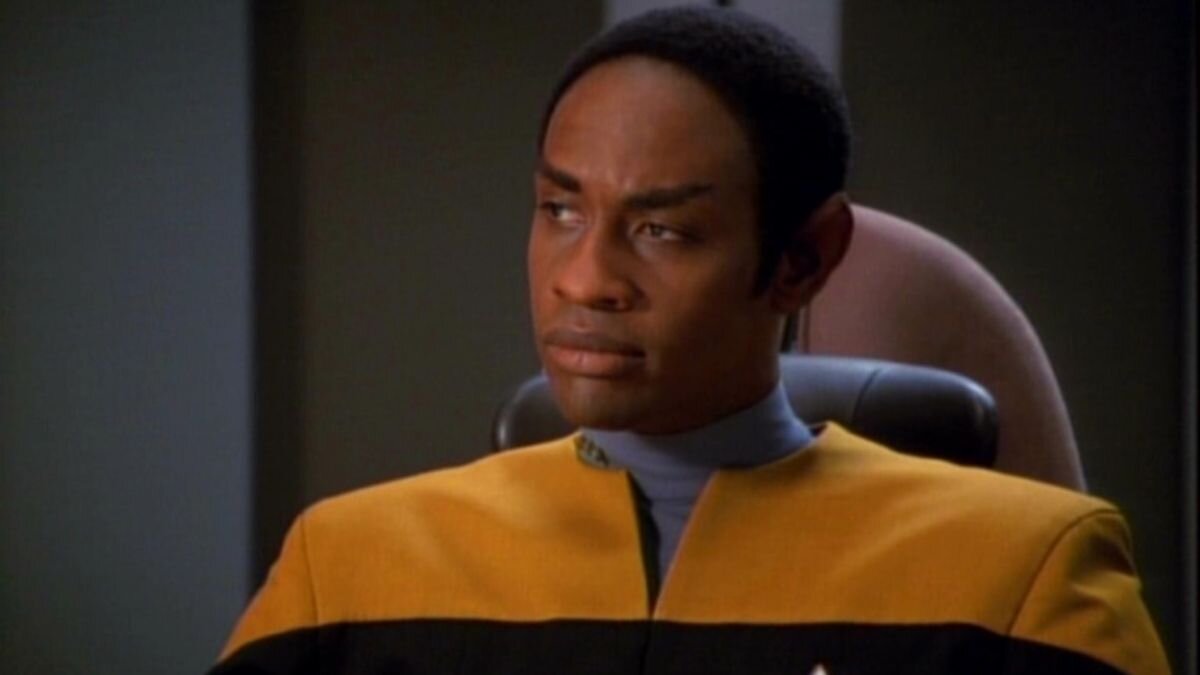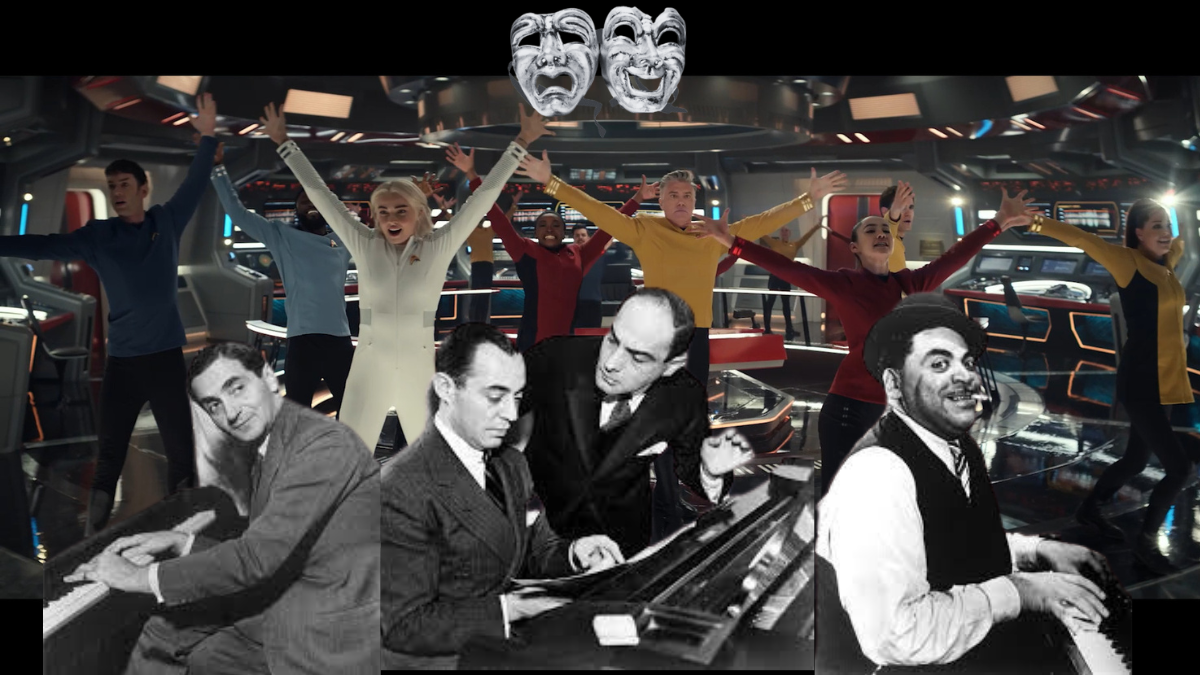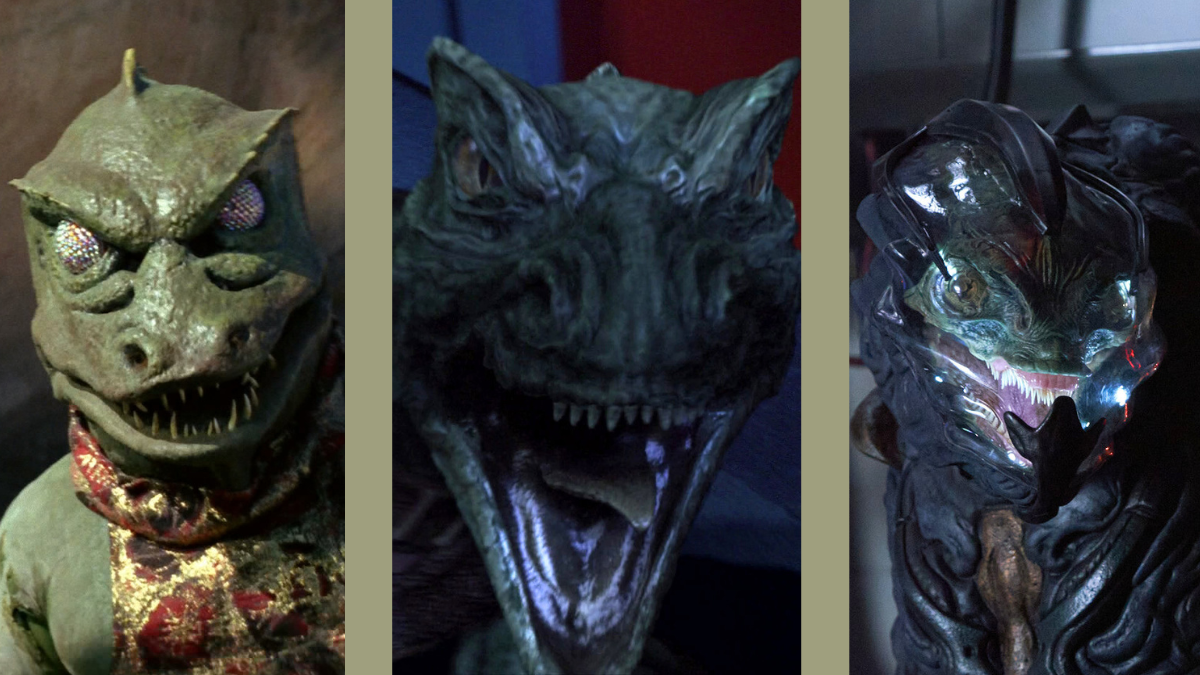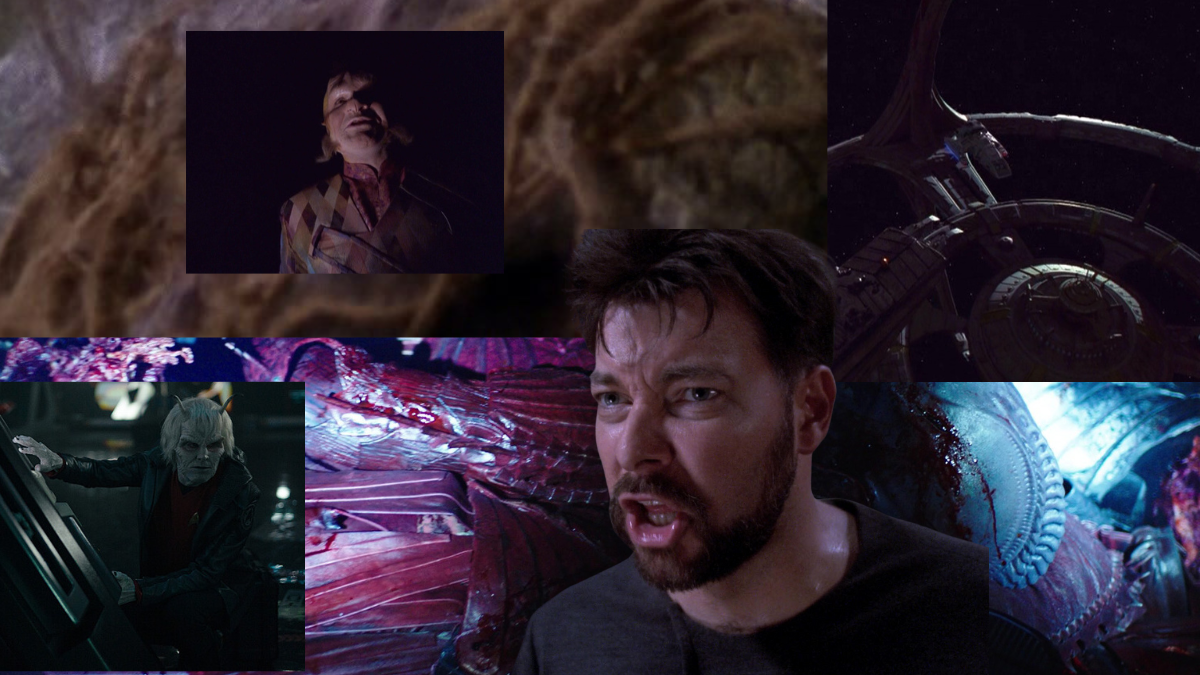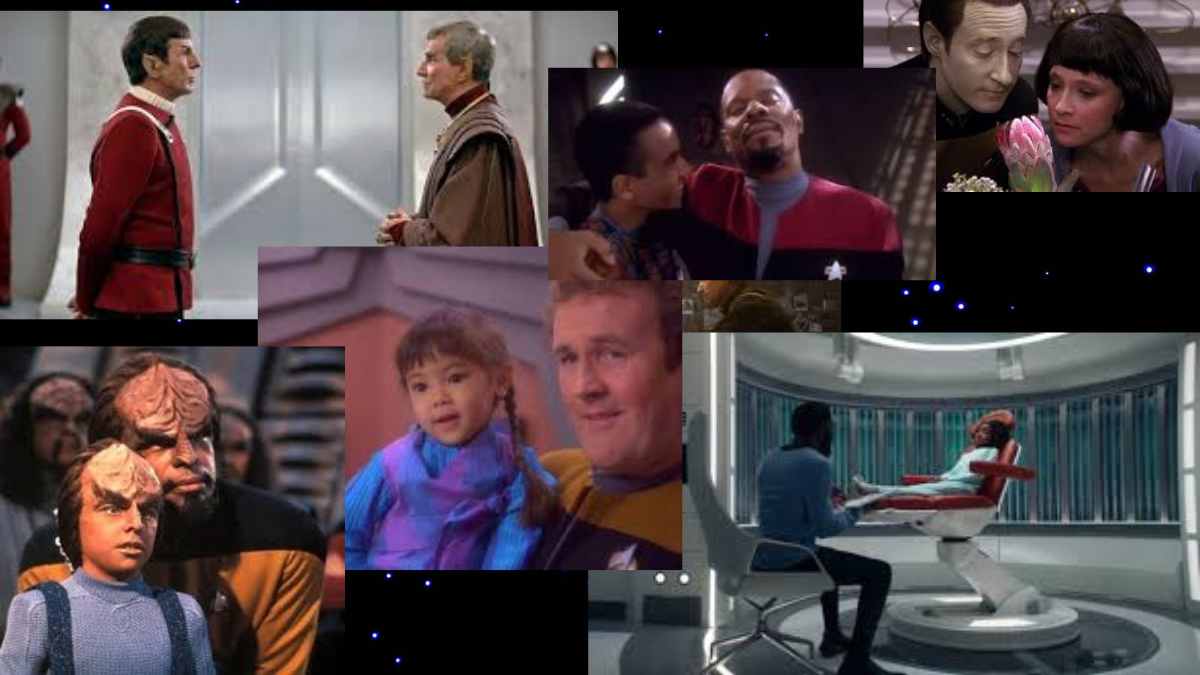TREKTROSPECTIVE: The Evolution of Federation-Klingon Relations in 'Star Trek'
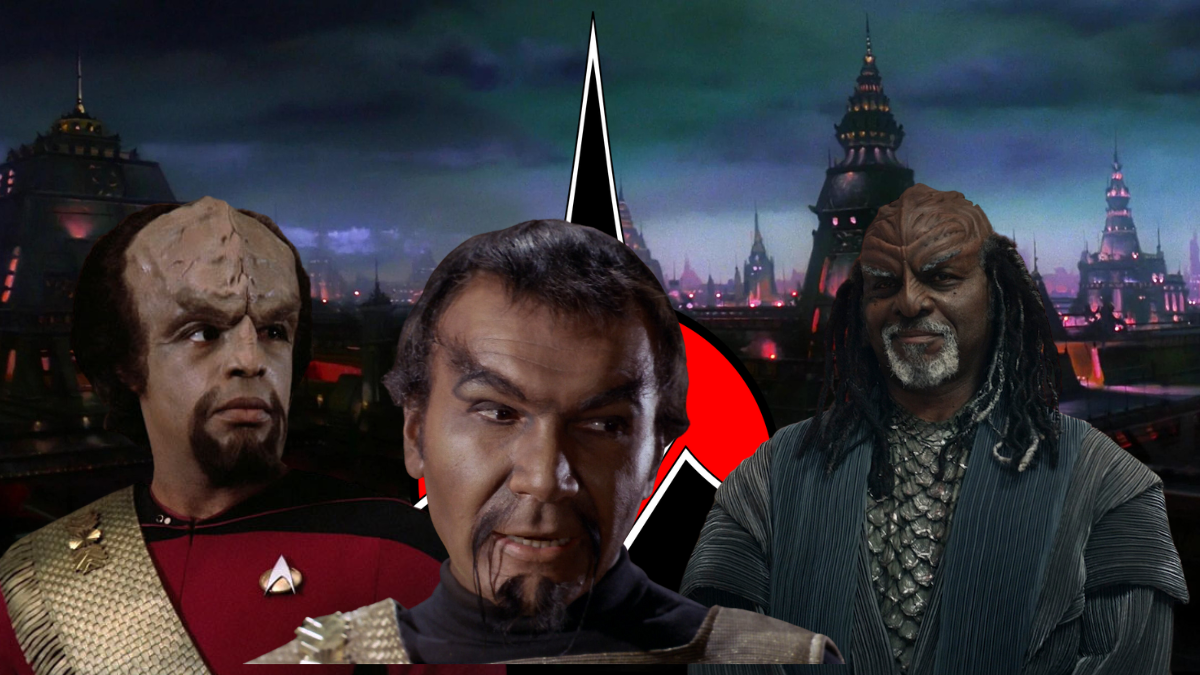
A variety of Klingons from STAR TREK. Images: Paramount.
This article contains spoilers for the Star Trek: Strange New Worlds episode “Under the Cloak of War.”
The Klingon alphabet. Image: Omniglot.
JULY 31, 2023 - Star Trek has a reputation for churning out mono-cultures, alien races that are defined by a single overarching trait. The Vulcans are logical; the Ferengi are greedy; the Romulans are secretive. Each alien, especially in the early years, displayed a human trait. Over the years, thanks to brilliant acting and writing, the long-running alien races became more nuanced and interesting. The same is true for the warlike Klingons.
Even a non-Trek fan might have heard of the Klingons. Their language can be learned via popular language courses like Duolingo; their likeness has graced any number of television commercials; Hallmark has created light-up Christmas tree ornaments in the shapes of their ships; and everyone knows the answer to the riddle “What do you call an alien you can’t get rid of? A Klingon!”
The latest episode of Star Trek: Strange New Worlds examines the fallout from the Klingons’ war with the Federation. But when did the idea for the race first take root, and how has their relationship with the Federation evolved over the course of 55 years?
“Errand of Mercy” and the History That Inspired It
Star Trek has a long history of quoting Shakespeare and the Bible, but the title of the first episode to feature the Klingons was taken from neither of those sources, instead borrowing from Charles Dickens.
“There is one quality which all men have, in common with the angels,” opines the philanthropic Charles Cheeryble in Dickens’ The Life and Adventures of Nicholas Nickleby. “Blessed opportunities of exercising, if they will, mercy. It is an errand of mercy that brings me here. Pray let me discharge it.”
“Errand of Mercy” involves a struggle between the Federation, represented by Captain Kirk (William Shatner), and the Klingons, represented by Captain Kor (John Colicos), over the cooperation of a neutral alien race, Organians. As with so many episodes of Trek, the story was a thinly-veiled attempt to comment on the state of the real world.
Gene Coon’s idea when writing the script was to create an alien race that was analogous to the Communist Party. The United States was in the midst of the Cold War with the Soviets and the Americans had recently been drawn into a ground war in North Vietnam. While public support for the offensive was overwhelmingly positive, many felt that there was a better alternative to war: peace.
Through the course of the Star Trek episode, it becomes obvious that Kirk, despite his protestations to the contrary, wants the war to continue. His hatred of the Klingons has blinded him to every other consideration. Kor, it seems, has similar feelings, although he’s not exactly two-dimensional, either. When he orders the deaths of thousands of Organians, he has some regrets. According to Coon’s script, as quoted in Marc Cushman’s These Are the Voyages: TOS Season One,
The Klingon commander is sitting at his desk, hands over his face. He is, at this moment, an unhappy man. The fact is, he does not relish butchering unarmed civilians. He is a soldier, and a good one. He sits quietly, brooding.
Kor may have been the bad guy, as far as the Federation and the audience were concerned, but in his mind he was simply doing his duty as a Klingon soldier fighting a war. But in Star Trek’s pacifistic view, no matter who wins the war, both sides are losers.
John Colicos as Kor in STAR TREK’s “Errand of Mercy.” Image: Paramount.
It takes the Organians, who are more than the elderly men they appear, to put an end to the hostilities, brokering peace between the two warring factions with their seemingly magical powers. Kirk and Kor are both annoyed at first. How dare the Organians interfere with their right to kill each other?
The episode, viewed as a classic now, was Coon’s attempt to show viewers the futility of war. The Klingons, who were named after Gene Roddenberry’s friend in the Los Angeles Police Department, Lieutenant Wilbur Clingan, appeared several more times in TOS, including season 2’s “A Private Little War,” a story that was a direct allegory of the Vietnam War, with the Klingons arming a faction of villagers on a primitive planet and Kirk violating the Prime Directive by arming the opposing side. The message: don’t interfere in a war that isn’t yours.
Reinventing the Warrior Race
The Klingons and the Federation don’t actually have a lot in common, but a hundred years after Kirk’s Enterprise was decommissioned, the next generation of explorers was enjoying an often uneasy peace with the warrior race.
Worf (Michael Dorn) threatens to blow a hole in the main viewscreen as Picard (Patrick Stewart), Yar (Denise Crosby), and Riker (Jonathan Frakes) look on in STAR TREK: THE NEXT GENERATION’s “Encounter At Farpoint.” Image: Paramount.
Star Trek: The Next Generation wasn’t supposed to feature Klingons. Roddenberry wanted to stay away from alien races and concepts that had been developed for TOS, but once he relented, a recurring character was written: Lieutenant jg Worf (Michael Dorn) was devised as a recurring character, appearing in seven of the first thirteen episodes of the series. It is ironic, then, that Michael Dorn has appeared in more hours of Star Trek than any other actor, with 278 episodes and 5 films under his belt. Worf is the only Trek character to appear as a regular character in more than one series (7 seasons of Star Trek: The Next Generation and 4 of Star Trek: Deep Space Nine.) Not bad for a dude who was intended for sporadic use only!
In the utopian future of Star Trek: The Next Generation, humans are no longer at war with anyone and the Klingons count among the Federation’s more recent allies. With a Klingon on the bridge of the Enterprise, we begin to get more of a sense of the race’s philosophy of honor, a detail that TOS’ allegorical Klingons lacked.
Worf’s “shoot now, ask questions later” approach, as displayed in the pilot episode “Encounter At Farpoint” when he aims his phaser at Q’s image on the main viewscreen, is a holdover from his Klingon heritage. “I will learn to do better, sir,” the junior officer promises his captain, but his warrior instinct doesn’t completely dissipate for another 35 years, at which point, in season 3 of Star Trek: Picard, he confuses his former crewmates by becoming a pacifist. “We will be friendly energy,” he proclaims in the episode “The Bounty,” to which Riker (Jonathan Frakes) responds, “I don’t understand the world anymore.”
Even after TNG was on the air, the original series cast was still taking on new adventures on the silver screen. 1991’s Star Trek VI: The Undiscovered Country acted as the final TOS-era film. Three years after the fall of the Berlin Wall, Trek was again presenting an allegory of current events. The inciting incident in the film is the destruction from the over-mining of the Klingon moon Praxis, leading to the Klingons’ need for the Federation’s help. The leading proponent of a peace treaty is Gorkon (David Warner), the Klingon Chancellor whose ideology mirrored that of then Soviet President Mikhail Gorbachev, just as his look was inspired by the 16th President of the United States Abraham Lincoln.
General Chang (Christopher Plummer) and Commander Kerla (Paul Rossilli) flank Chancellor Gorkon (David Warner), whose name is an amalgam of the real-world names Gorbachev and Lincoln. Image: Paramount.
Gorkon, like Lincoln, was assassinated for his beliefs, his final words, “Don’t let it end this way, Captain,” calling to mind Lincoln’s words on November 19, 1863, on the Civil War battlefield at Gettysburg, Pennsylvania, “we here highly resolve that these dead shall not have died in vain.”
And die in vain Gorkon does not. By the final reel, Kirk has resolved his complicated feelings about the Klingons, the conspiracy to disrupt the peace negotiations has been thwarted, and the original Enterprise and her crew have been called home for the last time. The bridge has been built between the first generation of Star Trek and the next one.
Another Time, Another War
Of, course, with a volatile, warlike race like the Klingons, you never know how long peace will last. In Star Trek: Deep Space Nine, the Federation-Klingon Alliance broke down, thanks to meddling by the Changelings. A deeper discussion of the Changelings and their invasion of the Alpha Quadrant is beyond the scope of this article, but suffice it to say that their final move before the invasion was to interrupt the peace that had begun in Star Trek VI.
When the Klingons invaded Cardassia despite the Federation’s condemnation of the action, all bets were off and all phasers were set to kill. The war was a relatively brief one, with a shapeshifter who had infiltrated the Klingon High Command manipulating events. and in the end the Federation and Klingon Empire returned to a peaceful relationship, ultimately allying with Cardassians and Romulans to defeat the Dominion in one humongous, all-out war.
Back to Basics
Star Trek: Enterprise went back to the beginning, acting as a prequel for the entire franchise, and endeavored to show the Federation’s first encounter with the Klingon race, before the first Federation-Klingon war. The show wasn’t as interested as TOS was in using the warrior race as an allegory, instead leaning into season 3’s Xindi arc as a parallel to the 9/11 attacks. Instead, we saw the heightened tensions between humans and Klingons, two races whose beliefs and ideologies were so different that they were unable to find common ground.
Another contribution ENT made was to explain how the Klingons temporarily lost their forehead ridges, allowing Kirk to encounter smooth-headed Klingons in TOS and ridged ones beginning with Star Trek: The Motion Picture (1979). In reality, the change between series and films had to do with larger budgets and an evolution in makeup techniques. While the change was somewhat controversial in ‘79, it wasn’t the last time the makeup would change.
The first characters we meet in Star Trek: Discovery’s pilot episode, “The Vulcan Hello,” are Klingons. These Klingons are unlike any we’ve met before, with new forehead ridges, causing even more real-world controversy, which deserves an essay in and of itself.
DISCO, acting as a sequel to ENT and a further prequel to TOS, tells the story of Michael Burnham (Sonequa Marin-Green) and the crew of the USS Discovery. Burnham inadvertently starts the first Federation-Klingon war when she stages a mutiny aboard the USS Shenzhou, captained by Phillipa Georgiou (Oscar winner Michelle Yeoh.)
T’Kuvma (Chris Obi) in the STAR TREK: DISCOVERY pilot “The Vulcan Hello.” Image: Paramount+.
Their forehead ridge patterns aren’t the only things that make these Klingons unique. DISCO premiered at a politically divisive time in the United States. Donald Trump had just been elected as the country’s 45th President, causing a fair bit of turmoil. Trump’s slogan of “Make America Great Again,” also known as his “America First” policy, would alienate other world leaders, and, as The Atlantic put it in 2020, would ultimately translate to “America Alone.”
As the DISCO pilot premiered in 2017, much of the Trump presidency was still in our future, but the writers saw the dangers. Klingon warrior T’Kuvma (Chris Obi) believed that Klingons should stay unallied, encouraging his followers to cry out “Remain Klingon,” a clear reference to Trump’s mantra. T’Kuvma was killed in the second episode of the series, but the movement of isolationists he inspired remained strong and the war raged on for nearly a year.
Making Peace
Which brings us to Star Trek: Strange New Worlds. The Klingons haven’t featured heavily in the series so far. They appeared in episode 201, “The Broken Circle,” with their TNG ridge patterns restored. And then again, in the latest episode, “Under the Cloak of War.” In the episode, Klingon ambassador Dak’Rah (Robert Wisdom) boards the Enterprise as a passenger. Upon reflection, he has ditched his isolationist ways and now preaches peace and unity between the Klingon Empire and the Federation.
The crew’s feelings towards “Rah” are complicated, especially since his reputation is as a leader who instructed his troops on the moon of J’Gal to torture and kill anybody they saw other than Klingon warriors. Over a thousand civilians were killed that day. According to Rah, his subordinates were responsible for the slaughter and he killed them in disgust, earning him the name “The Butcher of J’Gal.”
Doctor M’Benga (Babs Olusanmokun) and Ambassador Dak’Rah (Robert Wisdom) spar in the STAR TREK: STRANGE NEW WORLDS episode “Under the Cloak of War.” Image: Paramount+.
It turns out, however, Doctor M’Benga (Babs Olusanmokun) and Nurse Chapel (Jess Bush) were among the special forces doctors on the moon offering aid. In a fit of rage, M’Benga himself slaughtered the subordinates in an effort to assassinate Rah. “You turned me into a monster,” M’Benga proclaims before he kills Rah in a struggle over a knife. “I am the Butcher of J’Gal.”
The episode isn’t so much an allegory, as the Klingons seem to have been used in much of Star Trek history, but rather, it is a film depicting PTSD, the consequences of war, and what happens when one warrior (Dak’Rah) takes on another’s reputation with pride while the other (M’Benga) hides it in shame. In the end, as TOS tried to tell us, nobody wins.
If you want to learn a bit about how “Under the Cloak of War” was made, check out my interview with director Jeff Byrd in the Daily Star Trek News podcast feed wherever you get your podcasts. And if you’d like to ensure we continue to make content like this, why not support us on Patreon? Your donation not only helps us afford the hosting fees for our website and podcast but also helps us to pay our writers. Even a donation of as little as a dollar a month helps to keep us running. Head over to www.patreon.com/dailystartreknews to help us out!
T is the Managing Editor for Daily Star Trek News and a contributing writer for Sherlock Holmes Magazine and a Shakespeare nerd. He may have been the last professional Stage Manager to work with Leonard Nimoy, has worked Off-Broadway and regionally, and is the union Stage Manager for Legacy Theatre, where he is currently working with Julie Andrews. after which he’ll be working on Richard III at Elm Shakespeare Company.

